Full text html version. Thumbnails are linked to full-size figures. Fig. 10 provided w/large option:
Feliks,
J. 2008. Phi in the
Acheulian: Lower Palaeolithic intuition and the natural origins of
analogy. In Bednarik, R. G. and D. Hodgson (eds), Pleistocene palaeoart
of
the world, pp. 11-31. Proceedings of the XV UISPP World Congress
(Lisbon, 2006), British Archaeological Reports International Series 1804, Oxford.
Return to English main page; 回到中国主页; Vuelva a la p�gina principal espa�ola
PHI IN THE ACHEULIAN:
LOWER PALAEOLITHIC INTUITION
AND THE NATURAL ORIGINS OF ANALOGY*
John Feliks
U.S.A. E-mail: feliks (at) umich.edu
*This paper is the second half of
a two-part program which the author presented at the XVth UISPP
Congress. The first half was Program #C80-05, ‘The graphics of
Bilzingsleben: Sophistication and subtlety in the mind of Homo
erectus.’
Abstract: The
ratio 1.618, commonly known as the golden ratio or phi, has fascinated
the modern mind since the beginnings of Greek science and philosophy,
and many have made cases for its use as early as the Sumerian and
Egyptian civilizations. In this paper, however, I hope to demonstrate
that interest in the ratio extends much farther back in time than a
mere four or five thousand years, being already highly developed during
the Lower Palaeolithic. At whatever point it first occurred, I suggest
that interest in phi was an essential human trait that grew in tandem
with the human capacity for analogy. With the cranial ratios of Turkana
Boy (Walker and Leakey 1993) and the stone handaxe ratios of Gowlett
(1984, 1993) serving as stable early references, I provide evidence of
phi spanning 1.6 million years time. In the central studies, I expand
on the work of Mania and Mania (1988) and Bednarik (1995), and
demonstrate that the hominins at Bilzingsleben, Germany, 350,000 years
ago, continued the long established phi tradition in ways that prove
its existence beyond the long-debated handaxe ratio issue into
microlithic tools and intricate bone engravings, adhering more
accurately and more consistently to the ratio than the most often cited
examples in modern culture. The intense concentration of phi in so many
forms within Bilzingsleben is well beyond any expectations of chance.
Based on the evidence, I suggest that phi was not only a centralizing
element in general Acheulian culture but due to its intrinsic
analogical quality played a defining role in the actual development of
human cognition. Deliberate use of phi suggests that human
understanding of analogy occurred much earlier in our history than ever
anticipated, and by way of a “mathematical idea” which has
remained firmly rooted in human thought to this very day.
Keywords: Cognitive Archaeology, Bilzingsleben, Phi, Analogy, Linguistics
R�sum�: Le
rapport 1.618, commun�ment connu comme le “rapport
d’or” ou “phi”, a fascin� l’esprit
moderne depuis les d�buts de science grecque et de philosophie,
et beaucoup ont fait des cas pour son usage d�s les
civilisations de Sumerian et l’�gyptien. Dans ce papier,
pourtant, j’esp�re d�montrer que
l’int�r�t pour le rapport prolonge un beaucoup plus
lointain � temps que seul quatre ou cinq mille ans, �tant
d�j� hautement d�velopp� pendant le
Palaeolithic inf�rieur. � n'importe quel point il
s’est d’abord produit, je sugg�re que
l’int�r�t pour phi �tait un trait humain
essentiel qui a grandi dans de tandem avec la capacit� humaine
pour analogie. Avec les rapports cr�niens du “Gar�on
de Turkana” (Walker et Leakey 1993) et la continuit�
d’Acheulian handaxe rapports (Gowlett 1984, 1993) �tre les
fortes premi�res r�f�rences, je fournis
l’�vidence du rapport phi enjambant la p�riode de
1.6 million d’ans. Dans les �tudes centrales,
j’exame le travail de Mania et Mania (1988) et Bednarik (1995),
et d�montre que les hominids chez Bilzingsleben, Allemagne, il y
a 350.000 ans, ont continu� la longue tradition �tablie
de phi des mani�res qui prouvent son existence au del�
des d�tails souvent discut�s de rapport de handaxes vers
le contexte des outils microlithic et des gravures complexes d'os,
adh�rant plus exactement et plus uniform�ment au rapport
que les exemples le plus souvent cit�s dans la culture moderne.
La concentration intense de phi dans tant de formes dans Bilzingsleben
est bien au del� de toutes les esp�rances de chance.
Bas� sur l’�vidence, je sugg�re que phi
n’�tait pas seulement un �l�ment
centralisant en g�n�ral la culture d’Acheulian mais
en raison de son qualit� analogique intrins�que il a
jou� un d�finissant r�le dans le
d�veloppement r�el de cognition humaine.
L’utilisation d�lib�r�e de rapport de phi
sugg�re que la compr�hension humaine d’analogie se
soit produit beaucoup plus t�t dans notre histoire que jamais
pr�vue, et par guise d’une “id�e
math�matique” qui est demeur�e fermement
�tablie dans pens�e humaine m�me
jusqu’� aujourd’hui.
Mots cl�s: Arch�ologie Cognitive, Bilzingsleben, Phi, Analogie, Linguistique
INTRODUCTION
Archaeology has typically been reluctant to attribute conscious mathematical skills to any peoples other than our own species, Homo sapiens. The most advanced mathematical attribution even remotely considered for early peoples such as Homo erectus, Homo ergaster, Neanderthals, and Homo heidelbergensis,
is that of sequential counting. And although this counting is sometimes
extended to include the concept of “calendar,” more often
than not considerations never go beyond matters of simple tallying.
This has been a difficult perspective for archaeology to break away
from because in our zeal to see Homo sapiens
as an intellectual pinnacle, viewing early peoples as less intelligent
than us enables them to conveniently serve as
“half-way-there” links in a developmental chain. In this
paper, I hope to demonstrate that one advanced mathematical concept at
least–that of ratio–was well understood by all of the early
humans listed above, and that it was their natural inclination toward
the specific ratio of phi that led to the human cognitive attribute
known as analogy. Acknowledging the capacity for analogy in early
peoples is significant because it is through analogy that nearly all
aspects of advanced cognition become possible; whereas to acknowledge
only sequential counting need attribute nothing more to these peoples
than understanding the concepts of
Page 11
PLEISTOCENE PALAEOART OF THE WORLD
Page 12
accumulation, reduction, or simple
references to time. I suggest that our tendency to view sequentially
engraved lines in artifacts as mere tallies (if anything at all) has
caused us to miss the most meaningful core of mathematics, the
double-serving rational concept and intuitive sense of ratio.
It is not the purpose of this paper
to focus on the association between ratio (a mathematical term) and
analogy (a much broader term encompassing virtually every form of human
cognition, in that all cognition is based upon relationships between
abstract points). Rather, its purpose is to offer refutable
archaeological and morphological evidence that the capacity for analogy
developed during the Lower Palaeolithic as suggested by the mirror
concept of ratio–especially fractal ratio. Since the paper was
originally conceived as a visual program rather than thesis paper, it
will proceed simply by way of its Figures, but will also include brief
explanations of how the material fits into a larger system of analysis.
The figures offered represent approximately one third of those produced
for the Lisbon Phi
program, so the reader may rest assured that there already exists
substantially more evidence in support of the thesis forwarded.
INFLUENCES AND POSITION IN A LARGER SYSTEM
The theoretical aspects of this
paper were inspired by the work of Gowlett (1984, 1993), Mania and
Mania (1988, 2005), Bednarik (1995), Mandelbrot (1982), Eglash (1999),
Mikiten et al. (2000), Chomsky (1972), Sacks (1999, 2002), Capra (1982)
and others. However, the thesis revolves around three core ideas or
observations: (1) Gowlett’s observation that Acheulian people
were remarkably consistent in the length-to-width ratios of their
handaxes, a fact which he regards as a sign of “mathematical
transformations” (Gowlett 1984: 185), (2) Mania and Mania’s
and Bednarik’s observations that engraved artifacts at
Bilzingsleben represent the earliest graphic evidence of language, and
(3) various associations between seemingly unrelated elements, fractal
structures, systems, etc., influenced by the
work of Eglash, Mikiten, Chomsky, Pinker, Sacks, Greene, Capra, Bohm,
and others (as listed in the references).
To be detailed in a later
publication, I will explain here that the evidence offered is part of a
fractal system fully capable of translating the “core
ideas” of Lower and Middle Palaeolithic peoples. In this system,
facts work as concepts rather than traditionally like letters of an
alphabet, enabling access to complex Palaeolithic ideas without the
need for text or standard representational images. And while presently
not common in archaeology, the system also quite reasonably provides
access to ideas regarding various dimensions of time.
Bednarik and Mania and Mania have long promoted the idea that Homo erectus
and other early hominins had capabilities not far removed from our own.
It is through conclusions reached by thorough study and confidence in
their work that I decided to approach the matter from the top down
rather than the bottom up, and suggest that once a single profoundly
advanced capability is proven, no matter how esoteric it may seem
(e.g., use of a “dimensionless fundamental constant” such
as phi), the floodgates will open, and before long, discussions of
Lower Palaeolithic “philosophy” will be far more scientific
than discussions of whether
or not these people were intelligent enough to throw a stick, which is
essentially where the issue has been stuck for the past one hundred
years. Twenty years ago the idea of “cognitive archaeology”
itself (a term coined by Colin Renfrew) seemed an impossible pursuit.
This is obviously no longer the case as researchers are coming into the
field in droves from every other field imaginable.
To clarify an earlier point, the
challenge that phi and other ideas in the new paradigm presents for
anthropology is that early hominins can no longer be used as convenient
“half-way-there” links between the lowly Ardipithecus and the allegedly superior modern Homo sapiens.
Other perspectives will need to be adopted because in light of all the
evidence for higher culture beginning to surface the
smaller-than-sapiens brain of Homo erectus
now creates as much of a problem for the idea of gradually evolving
intelligence as did the larger-than-sapiens Neanderthal brain. Brain
configuration theories are equally weakened as they too position
evolving intellectual ability as a given. Bednarik has long stated that
human intellectual development had nothing to do with physical
evolution. I concur, but am compelled one step further, and suggest
that the very idea of gradually increasing intellectual ability (not
accumulation of knowledge) is itself a myth. In other words, once
someone brought out the football, in this case, consciousness based on
analogy, there were plenty who could already instantly run with it.
Analogy, as I propose, was the idea that engendered other ideas. The
hard part was the initial idea or spark. Assimilation of the idea into
culturally-preserved cognition, and subsequent rapid accumulation of
other ideas was comparatively effortless. The Acheulian age discovery
of phi by Homo erectus
engendered a “mathematical” idea which had a profound
effect on all subsequent human species and which suggests that the
completely modern human mind began 2 million years ago rather than a
mere 40, 100, or even 350 thousand years ago. For these reasons I
suggest that phi is the oldest abstract knowledge passed down intact by
way of culture, and support this proposition with its unique
testability. It is regarded a significant related matter that the
oldest large-scale non-hemispheric ratio within the human brain is also
phi (as demonstrated below). Accrediting phi and analogy appropriately
to Homo erectus
solves many problems that have long hindered cognitive archaeology, not
the least of which was the specific ability to create fire. As another
critical example, the aptitude for analogy also makes the island
hopping of this species over 800,000 years ago (an idea fully developed
in Bednarik’s [1997] open sea bamboo raft voyages) not the least
bit difficult to accept; otherwise we are stuck with old paradigm views
such that
J. FELIKS: PHI IN THE ACHEULIAN: LOWER PALAEOLITHIC INTUITION AND THE NATURAL ORIGINS OF ANALOGY
Page 13
Figure 2.1.
Long-time awareness and use of the Phi ratio, 1.618. (a)
Gowlett’s observation regarding consistency of handaxe ratios
from Kilombe, Kenya, over a wide range of sizes (the largest is 17cm),
c. 700,000 BP. 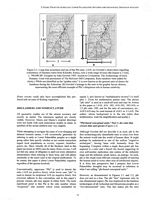 (Graphic by John Gowlett 1993. Ascent to Civilization: The Archaeology of Early Humans.
Used with permission of The McGraw-Hill Companies. Ratio numbers were
added for clarity.) While not identified as the “golden
ratio,” it is now known as the general ratio of choice for
handaxes during the Acheulian. (b) Gowlett’s homage to the ratio
in his graphic layout choices, representing the most efficient example
of Phi’s ubiquitous role in human creativity.
(Graphic by John Gowlett 1993. Ascent to Civilization: The Archaeology of Early Humans.
Used with permission of The McGraw-Hill Companies. Ratio numbers were
added for clarity.) While not identified as the “golden
ratio,” it is now known as the general ratio of choice for
handaxes during the Acheulian. (b) Gowlett’s homage to the ratio
in his graphic layout choices, representing the most efficient example
of Phi’s ubiquitous role in human creativity.
Homo erectus could only have accomplished this profound task on mats of floating vegetation.
DISCLAIMERS AND NOMENCLATURE
All geometric studies are of the utmost accuracy and exactly as stated. The tolerances applied are clearly visible. However, Mania and Mania’s original drawings were not made with such meticulous studies in mind, so qualities of the actual artifacts may vary slightly.
While attempting to navigate the maze of ever-changing and debated hominin names, I will occasionally generalize by referring to early or Lower Palaeolithic peoples as a single group rather than specify whether or not certain researchers regard local populations as erectus, ergaster, heidelbergensis, etc. Since virtually all of the literature cited in this paper (as recent as 2005) uses the name Homo erectus, I will not feel any sense of obligation to spell out every alternative interpretation when referring to these texts, and will adhere essentially to the name used in the original publications. To be certain, this paper is about Lower Palaeolithic cognition regardless of the species involved.
Conventionally, uppercase “Phi” is used to denote the ratio 1.618 (or positive form), while lower case “phi” is used to denote its reciprocal .618 (or negative form). Not everyone adheres to this convention, and in this paper’s present version, phi may appear in either form. The most significant point is that Phi is the only number whose “reciprocal” (the number which when multiplied by equals 1; also known as “multiplicative inverse”) is itself plus 1. [Note for mathematics purists only: The phrase “phi ratio” is used as a catch-all term and may be written in this paper as 1.618, .618, .382, .618/.382, .382/.618, or 1/2 phi ratio .309, and for the sake of convenience, etc., .618/1.618 may be used instead of .618/1 or 1/1.618. The author, whose background is in the arts rather than mathematics, went for simplification and poetry.]
“Phi-based conceptual units,” Part 1: the ratio that
crosses time and species (Figure 2.1)
Although Gowlett did not describe it as such, phi is the first archaeologically identifiable ratio to cross over from the natural world into the world of human ideas. It might perhaps be understood as one of the earliest “cognitive archetypes”, having been with humanity from the beginning. Complete within a single three-point phi line segment is a ratio and a fractal–the fractal suggesting its own self-similar replication into realms of the infinitely large and the infinitely small, hence, an analogy. As such, phi is the single most efficient concept capable of opening the human mind to every other area of intellectual inquiry. It is from this perspective that I propose that Lower Palaeolithic thoughts may be accessed in reference to what I am calling “phi-based conceptual units.”
However, as demonstrated in Figures 2.1 and 2.2, phi does not end as a line. The phi “line” represents only its one-dimensional aspect. Phi was employed in the handaxe technologies of all Acheulian and Mousterian peoples as a “two-dimensional” ratio. This fact makes phi the ratio
PLEISTOCENE PALAEOART OF THE WORLD
Page 14
Figure 2.2.
Phi measuring tools. These shapes are based on the ratio 1.618, and are
commonly known as (a) “golden line, (b) “golden
rectangle,” and (c) “golden spiral.” 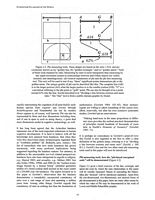 Each of these
tools measure by ratio. Measuring by ratio is more transparent than
measuring by any equal-increment system as relationships between and
within objects are visible instantly and unambiguously. (d) General
explanation of phi and the phi line measuring tool. This tool will be
used to test if any “three” significant points demonstrate
phi or the golden mean. The unique quality of phi can be described like
this: The complete line (AB) is to the larger portion (AG) what the
larger portion is to the smaller portion (GB). “G” is a
convention referring to the phi point or “gold” point. Phi
can also be thought of as a point around 62% into the line. Euclid
described it as “dividing a line between extreme and mean
ratio.” The “line” tool is from a public domain
graphic by Eisnel.
Each of these
tools measure by ratio. Measuring by ratio is more transparent than
measuring by any equal-increment system as relationships between and
within objects are visible instantly and unambiguously. (d) General
explanation of phi and the phi line measuring tool. This tool will be
used to test if any “three” significant points demonstrate
phi or the golden mean. The unique quality of phi can be described like
this: The complete line (AB) is to the larger portion (AG) what the
larger portion is to the smaller portion (GB). “G” is a
convention referring to the phi point or “gold” point. Phi
can also be thought of as a point around 62% into the line. Euclid
described it as “dividing a line between extreme and mean
ratio.” The “line” tool is from a public domain
graphic by Eisnel.
equally representing the cognition of all post-habilis early human species from ergaster and erectus through heidelbergensis and Neanderthal (its use by modern Homo sapiens
is, of course, well known). Phi can also be represented in three and
four dimensions including time, and if one is open to such as string
theory, a great deal more dimensions useful in cognitive archaeology,
as well.
It has long been agreed that the Acheulian handaxe represents one of
the most important milestones in human cognitive development. It is
hard to believe with all the knowledge now gleaned from handaxes, that
when they were first discovered many archaeologists regarded them as
“worthless pebbles” (R. Bednarik, pers. comm.). The list of researchers
who now study handaxes has grown immensely, with many profound
implications being suggested regarding the handaxe makers. For
instance, in addition to
the uncountable survival–related perspectives, handaxes have also
been interpreted in regards to religion, e.g., Harrod 2003; and
sexuality, e.g., Mithen 2003. See also Feliks 1998a, 1998b, and 2006
for the “earliest iconic image framed by a human being”
(detailed geometric studies of a fossil scallop shell located in the
exact center of a 250,000 year old handaxe). The aspect focused on in
this paper is Gowlett’s observation that the handaxe demonstrates
a remarkably unexpected consistency of ratio over a vast range of sizes
and spanning a million years time. Among other things, Gowlett regards
this consistency of ratio as nothing less than the foundation of
mathematics (Gowlett 1984: 183–85). Most archaeologists are
willing to admit something of this nature now, albeit, reservedly, but
after his own extensive systematic studies, Gowlett had no reservations:
“Making
hand-axes in the same proportions at different sizes provides the
earliest practical demonstration of principles treated hundreds of
thousands of years later in Euclid’s Elements of Geometry” (Gowlett 1993: 71).
It is perhaps no coincidence in Gowlett’s point-of-view that Euclid is
also regarded as the first to offer a clear definition of the golden
mean, referring to it as “dividing a line between extreme and mean
ratio” (Euclid, c. 300 B.C.). Euclid’s line and the two other main phi
measuring tools used in this paper will now be introduced.
Phi measuring tools: how the “phi-based conceptual
units” will be demonstrated (Figure 2.2)
Figure 2.2 gives a brief overview of the line, rectangle, and spiral
phi tools by which the ratio relationships in this paper will be
visually measured. Means of calculating the Palaeolithic phi
“decimal” will be introduced separately. Apart from the
one-dimensional, two-dimensional, and decimal forms of phi demonstrated
in this paper, there are many other means by which the value of Phi may
be demonstrated in the work of Lower and Middle Palaeolithic peoples.
J. FELIKS: PHI IN THE ACHEULIAN: LOWER PALAEOLITHIC INTUITION AND THE NATURAL ORIGINS OF ANALOGY
 Page 15
Page 15
Figure 2.3.
Phi in the Bilzingsleben microliths. (#s 1–11 & 13–16)
Compiled from J. Svoboda, 1987. Lithic industries of the Arago,
V�rtessz�ll�s, and Bilzingsleben hominids: Comparison
and evolutionary interpretation. Current Anthropology
28(2): 219–27. Used with permission of The University of Chicago
Press. (#12) D. Mania and U. Mania 2003. Bilzingsleben - Homo erectus,
his culture and his environment. The most important results of
research. In Lower Palaeolithic Small Tools in Europe and The Levant.
Edited by J.M. Burdukiewicz and A. Ronen, BAR S1115, 2003:29–48. Used with permission.
“Phi-based conceptual units,” Part 2: Phi fractals in the
Bilzingsleben microliths (Figure 2.3)
Bilzingsleben has sometimes been classified as an Acheulian site that
lacks the standard Acheulian handaxe. However, as Mania and Mania point
out (2005: 105–6), many of the
microlithic tools are “reminiscent” of bifaces (tools worked on both
front and back like handaxes, and often patterned in the well-known
tear shape). This is actually an understatement, as many of the
microliths are exact replicas of Acheulian handaxes only in miniature. Although there are many ratios represented in the Bilzingsleben
microliths, for this paper I have only isolated a few that specifically
demonstrate perfection of the phi ratio.
The earliest perfection of miniaturization: Seeing the
miniature phi ratio at 10x magnification (Figure 2.4)
While the microliths are not the smallest example of Phi at Bilzingsleben (for the measure presently holding this position see Fig. 2.17),
they are certainly the smallest examples of a standardized 2-D
phi-based shape with a proven creative history of over a million years.
They represent
“flawless” variations on a standard whose duration of
existence has never been surpassed, nor, likely, ever will be.
This early example of a technology’s progression from extremely large
to extremely small (i.e. Acheulian phi handaxes to Acheulian phi
microliths) is not at all unlike innumerable examples in our own time
such as evidenced in the similar developments of gears and microchips.
And considering the restricting factors with which Lower Palaeolithic
peoples were working–such as the slower spread of ideas due to smaller
populations, lack of “easy access” to externally-stored knowledge
(Donald 1991), or the fact of there not being any great need driving
miniaturization (e.g., such as overpopulation)–that it occurred at such
a high level of refinement despite these factors is perfectly
comparable to our own transition from building room-sized computers to
building microcom-
PLEISTOCENE PALAEOART OF THE WORLD
Page 16
Figure 2.4.
Gowlett’s phi ratio discovery demonstrated to perfection by the
Bilzingsleben microliths. This is the earliest evidence of
miniaturization adhering to an identifiable mathematical ratio. Each
enclosing rectangle is a “golden rectangle” in the ratio
1.618. 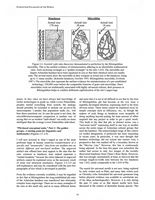 The microliths and largest Acheulian handaxe have been equalized
in size so that their identical ratios are readily seen. The several
insets show the microliths as they compare in actual size to the
handaxes, being up to 11 times smaller. (Kilombe handaxes, Gowlett
1993. Bilzingsleben microliths, Svoboda 1987.) The microliths also
represent the earliest evidence for miniaturization of a
pre-established technology, 350,000 years before the comparable
histories of gears and microchips. Since microlithic tools are
traditionally associated with highly advanced cultures, their presence
at Bilzingsleben helps to confirm deliberate sophistication of the
site’s engravings.
The microliths and largest Acheulian handaxe have been equalized
in size so that their identical ratios are readily seen. The several
insets show the microliths as they compare in actual size to the
handaxes, being up to 11 times smaller. (Kilombe handaxes, Gowlett
1993. Bilzingsleben microliths, Svoboda 1987.) The microliths also
represent the earliest evidence for miniaturization of a
pre-established technology, 350,000 years before the comparable
histories of gears and microchips. Since microlithic tools are
traditionally associated with highly advanced cultures, their presence
at Bilzingsleben helps to confirm deliberate sophistication of the
site’s engravings.
puters. In fact, since we have always had knowledge of earlier
technologies to guide us, while Lower Palaeolithic peoples started
everything from scratch, the analogy should probably be extended to
include our as-yet-to-be nanocomputer. I predict that population math,
etc., will bear these
assertions out. In case the point is not clear, the
microlith/microcomputer comparison is another way of saying that we as
modern “individuals” are really no more intelligent than
the average Lower Palaeolithic individual.
“Phi-based conceptual units,” Part 3: The golden groups:
A starting point for linguistics and mathematics (Figures 2.5–2.6, 2.8-2.9)
I will now proceed to what I regard as one of the most profound leaps in human creativity–transformation of a specific and “measurable” idea from one medium into an entirely different and unrelated medium.
The engraved artifact sets offered here lend support to the idea that
the ratio common to handaxes does indeed represent a “mental template,”
because the ratios inherent in engraved
artifacts cannot be explained away as the necessary result of stone
tool structural mechanics. Figures 2.5–2.6, 2.8-2.9 are self-explanatory
and may be considered with the next few paragraphs of text which is
developed in parallel.
From the evidence currently available, it may be regarded as fact that
at Bilzingsleben the long-established phi ratio of the Acheulian
handaxe was transferred into intricately complex bone engravings. There
are so many examples of the ratio at this small site, and in so many
different forms and sizes that it is not at all difficult to see that
by the time of Bilzingsleben, phi had become, at the very least, a
superbly developed intuition, expressing itself in far from obvious
terms. These terms cannot be explained away by simple concepts such as
efficiency, etc., as though the makers of such things as handaxes were
incapable of doing anything beyond putting the least amount of effort
required into any project in order to get a quick result. This leads to
the idea that phi, in abstract terms, was a “universal
motif” expressing itself in one way or another across the entire
range of Acheulian cultural groups that used the handaxe. The
acknowledged range of this culture (or toolkit designation, if
preferred) has been expanding in recent years. In particular, it was
once thought that handaxe technology did not extend into eastern Asia,
a perspective that was marked off by a boundary known as the
“Movius Line.” However, this line is continuously being
adjusted. At the time this paper was submitted, the author had access
to only two images of the recently discovered handaxes from
China’s Bose Basin. However, that was enough, momentarily at
least, to discover that the average length-to-width ratio between the
two handaxes was 1.642, easily comparable to the 1.618 of Phi.
The search for universal motifs is not new, being explored by early
writers such as Plato, and many later writers such as Chomsky (who
formulated his universal grammars long before physical evidence was
available to corroborate any of his ideas archaeologically). However,
it is only during the past 15 years or so that shared motifs have been
discussed in the context of dissimilar human species. This
J. FELIKS: PHI IN THE ACHEULIAN: LOWER PALAEOLITHIC INTUITION AND THE NATURAL ORIGINS OF ANALOGY
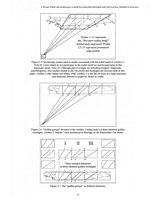 Page 17
Page 17
Figure 2.5. Numbering system used in studies associated with the radial motif of Artifact 2. Note #1: Lines which do not participate in the radial motif are not focused upon in this particular series. Note #2: Although part of a larger set including triangles, trapezoids, parallelograms, only studies related to phi via circles and rectangles are focused upon in this paper. Artifact 2 after Mania and Mania 1988. Artifact 2 is the flat rib bone of a large mammal, and measures 286mm in length by 36mm in width.
Figure 2.7. The “golden groups” as isolated characters.
PLEISTOCENE PALAEOART OF THE WORLD
Page 18
Figure 2.8. Diminution
and augmentation in the Artifact 2 golden groups. These and other terms
were appropriated from Bach fugue writing and are useful tools for
exploring analog structures in language (e.g., revisiting the deep and
surface structure of Chomsky’s “universal grammar”)
and mathematics (e.g., progressive fractals, logarithm), to name only
two. 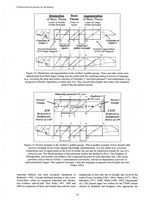 They can provide insights into many other disparate areas of the
pre-sapiens psyche.
They can provide insights into many other disparate areas of the
pre-sapiens psyche.
Figure 2.9. Inverse
triangles in the Artifact 2 golden groups. This is another example of
how fractals offer access to multiple levels of pre-sapiens knowledge
simultaneously. It is not unlike how a musical composition may be
appreciated on the level of sound, but can also be understood silently
by way of a musical score. The fractal qualities of this particular
artifact are detailed in Part I, The Graphics of Bilzingsleben,
and extend even further to the compound structure of each individual
line. Like music, geometry such as that of Artifact 2 communicates
universally, and has no dependence upon text or representational
images. This supports Chomsky’s idea that language is separate
from thought (see also Pinker 1994).
important addition was most succinctly introduced in Bednarik’s 1995, Concept-mediated marking in the Lower Palaeolithic,
where he compared Acheulian and Mousterian evidence side-by-side. (See
Feliks 1997, 1998 and 2006 for expansion of these and related ideas and
for some background
on how this line of thought also involved the work of Leroi-Gourhan
[1961, 1964], Oakley [1973, 1981], Marshack [1977, 1990], White [1989,
1993], Dissanayake etc.) The present paper was written for the UISPP
session chaired by Bednarik and Hodgson (who approaches the
J. FELIKS: PHI IN THE ACHEULIAN: LOWER PALAEOLITHIC INTUITION AND THE NATURAL ORIGINS OF ANALOGY
Page 19
field from the perspective of neuroscience) which included a specific call for researchers to begin identifying universals in the archaeological record.
A most important new approach toward understanding early human thought involves fractals, as brought to the fore by researchers such as Eglash and Mikiten. Fractals are patterns which exhibit repeating “self-similar structure” at larger or smaller sizes (i.e. “fractal levels”), and can be expressed in many different ways including abstract terms; but they are most easily visualized two-dimensionally such as seen in the branches and leaves of ferns. Most of the math regarding fractals has only been developed during the past 25 years or so beginning with the landmark work of Mandelbrot (e.g., 1982). Since then, fractals have transformed every field of science, and the influence of fractals on ideas in philosophy, psychology and neuroscience is profound. It is from this perspective that I am proposing the phi fractal as an early cognitive archetype via “phi-based conceptual units.” Phi has the ability to serve such a role because it has proven cohesive enough to cross from its already critical role in the natural world into the cognitive world of human creativity. The following perspective, while not specifically referring to phi, adds support to the idea of phi-based conceptual units:
“When a fractal system generates a new system, it has the same attributes and characteristics as the generator… Thus, mental associations that would appear at first to require enormous lengths of code (and consequently be termed complex) may in fact be handled by very short codes. If that is indeed the case, then the human mind could be using fractal encoding as a standard way of coding enormous chains of related thought into a single fractal entity” (Mikiten et. al. 2000).
The fractal system I am proposing revolves around how a single ratio, namely Phi, can have major cognitive implications on uncountable sub-levels (or supra-levels as used in analogy). This is born out by the many subtle variations on this single theme demonstrated in Figures 2.5–2.18.
Beyond the obvious examples of “perfect” phi, I suggest that minor deviations from the ratio (e.g., as visible in the off-diagonal points of Gowlett’s graph, Fig. 2.1) reflect the natural tendency of all peoples to develop subtleties of discernment according to their specific geographic or cultural environments. One of the best ethnographic examples is how cultures with no history of vertical development in music (i.e. chordal, contrapuntal) develop extremely subtle horizontal (i.e. melodic) sensitivity. To take this particular example one step further, the entire “Western” system of music is based on simple half-tones, which can never compare in melodic subtlety to cultures whose music uses extensive quarter-tones such as that of various Arabic and Indian cultures. Western trained ears are scarcely able to grasp it beyond the sensual level of sound, and psychologically may attempt to “round off” the quarter tones to the nearest half-tone, or relate such things to ornamental bending effects, etc. What I am suggesting by all of this is that we may have mistakenly interpreted the Acheulian as a “static” culture (or technology) when, in reality, it may actually represent a culture of refined subtleties, indicating high intelligence rather than the low intelligence we have traditionally ascribed to Acheulian peoples. I suggest (after e.g., Capra 1982, Bohm and Peat 1987) that a primary reason we see such things as reflecting crudeness rather than refinement has a Western science bias at its core, reflecting, among other things, our longtime preoccupation with the Cartesian grid system. It is interesting to note that since the current expansion of fractal awareness in Western science, all manner of sensibilities are being discovered where before, we could only see chaos.
Although fractal techniques have great potential for Palaeolithic linguistics (as introduced in Feliks 2006 and in the Graphics paper), the primary focus in this paper and the larger fractal system in general is to approach concepts which do not require text or representational images in order to be understood, i.e. cognitive archetypes. Cognitive archetypes can take many different forms, not the least of which are those present in music. Music, like words, need not be “heard” in order to be understood. In fact, as hard to believe as it may seem, someone born deaf, who has never experienced [hearing] on any level can learn to compose music–even music of a complex contrapuntal texture–all by way of “theory” to such a degree that even a trained listener could not distinguish a piece written by a deaf person from one written by someone with normal hearing, hence, the following interpretations of Bilzingsleben Artifact 2 in the terms of Western classical music (Figs. 2.8–2.9). (Note: In The graphics of Bilzingsleben and Musings on the Palaeolithic fan motif, I demonstrated how this particular artifact can also be read in terms of musical scales and rhythms, which has immediate application potential to Lower Palaeolithic spoken language.)
The golden mean in Artifact 2 circle studies, and an
appeal to physics and astronomy (Figure 2.10, [Figure 2.10 LARGE MAGNIFICATION])
Once it is understood that the influence of phi extends well beyond visible shapes or abstract numbers, much more information can be gleaned from the few Acheulian (or Mousterian) artifacts we have available for study. As noted in the Graphics paper, by employing extensions of engraved lines, we can access the geometric mind behind and beyond the artifacts themselves. This is possible because geometric extensions make accessible an invisible field of information outside of, but within the vicinity of, any given artifact. The extent of this field is more limited in some artifacts than in others, and the further out we go from various artifacts the more speculative the interpretations may be. However, depending on what specific information we are seeking, and despite what may be presumed, this is not necessarily the case, as demonstrated in the section of Graphics called “Proof of association between an abstract point and infinity.” Depending on how the lines are organized, many interpretations of a surrounding field are perfectly safe.
If all of this seems absurd, I appeal to a well-established scientific field which, in reality, has no direct contact whatsoever with 99% of the objects it studies–namely, astronomy. Astronomers, astrophysicists, cosmologists assume
PLEISTOCENE PALAEOART OF THE WORLD
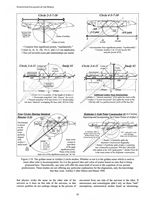 Page 20
Page 20
Figure 2.10.
The golden mean in Artifact 2 circle studies. Whether or not it is the
golden mean which is used or some other ratio is inconsequential, for
it is the general idea and value of syntax based on ratio that is being
proposed here. Theoretically, any ratio will offer the same kind of
access to the cognition of our ancient predecessors. These studies are
not offering any particular explanation for the alignments, only the
knowledge that they exist. Artifact 2 after Mania and Mania 1988. [Click here for Figure 2.10 LARGE MAGNIFICATION.]
that physics works the same on the other side of the universe as it
does on this side of the universe, or that various qualities do not
undergo change in the process of movement from one side of the universe
to the other. If astronomers and cosmologists didn’t rely on
these “safe” assumptions, astronomical studies based on
electromag-
J. FELIKS: PHI IN THE ACHEULIAN: LOWER PALAEOLITHIC INTUITION AND THE NATURAL ORIGINS OF ANALOGY
Page 21
Figure 2.11.
Further evidence suggesting a grasp of ratio as it relates to Phi. (a)
3 groups of 7: Golden rectangles superimposed over Artifact 1.  While
not as perfect a fit as the Artifact 2 “golden groups,”
this study suggests a definite unity of style between Artifacts 1 and
2. (b) Artifacts 1 and 2 compared. Both the motifs and rectangles are
at the exact same scale, further supporting the idea of
“phi-based conceptual units.” Combined length lower
rectangles=160mm. Artifact 1 is the tibia bone of a straight tusked
elephant. Drawing after photograph by R. Bednarik 1997. Artifact 2
after Mania and Mania 1988.
While
not as perfect a fit as the Artifact 2 “golden groups,”
this study suggests a definite unity of style between Artifacts 1 and
2. (b) Artifacts 1 and 2 compared. Both the motifs and rectangles are
at the exact same scale, further supporting the idea of
“phi-based conceptual units.” Combined length lower
rectangles=160mm. Artifact 1 is the tibia bone of a straight tusked
elephant. Drawing after photograph by R. Bednarik 1997. Artifact 2
after Mania and Mania 1988.
netic waves, photons, neutrinos, etc., could not be used to tell us anything at all regarding the chemical composition or age of distant stars. Everything we know about quasars and galaxies, even the Big Bang, is all derived by inference. From this perspective, therefore, I suggest that cognitive archaeology may just as appropriately infer past thought via artifacts and other items with which early peoples came into contact, since this may be regarded as evidence of equal veracity to that used in astronomy. In other words, our evidence is much closer to us in both space and time than nearly all of the evidence used in astronomy. We are able to make “direct” contact with the artifacts and even the find horizons. The only major problem, and it is substantial, is that the evidence used in cognitive archaeology is infinitely less abundant.
“Phi-based conceptual units,” Part 4: Consistency of
phi enclosures between two artifacts (Figure 2.11)
In the Graphics paper, I demonstrated that the same motif had been duplicated on two separate artifacts. The reason this was an important step is because duplicated motifs are the very hallmark of human language. A single motif can represent anything from a letter in an alphabet to the most complex multi-level construct anyone has ever imagined. And if a culture also understands variation, association, fractals, or any other concepts at all, then this very same motif can represent any number of different ideas variable by orientation, time, accompanied behavior, etc. A single motif, in other words is as versatile in the realm of communication as the Acheulian handaxe is if limited to only its utilitarian potentials. Comparing a visual motif with a single spoken word automatically takes the motif into infinitely different dimensions. With variations of inflection, repetition, etc., that one word can communicate a thousand subtle ideas.
With that background regarding the infinite potentials contained within a single motif, it is obvious how this can be expanded logarithmically when several already “loaded” motifs are used in combination with other motifs. This, of course, is nothing whatsoever new in linguistic study (see Chomsky 1972, Pinker 1994); the only thing that is new is that we are now talking this level of sophistication in regards to Lower Palaeolithic hominids.
“Phi-based conceptual units,” Part 5: Fractal
associations within Artifact 6 (Figure 2.12)
“Phi-based conceptual units,” Part 6: Fractal associations
between engravings and microliths (Figure 2.13)
The earliest “graphic” dividing line: Decimal theories 1
& 2 (Figures 2.14 & 2.15)
The earliest “graphic” dividing line: Mirror theory
(Figure 2.16)
14 instances of phi in a seven-line motif (Figure 2.17)
Although evidence such as that presented in Fig. 2.17 may seem remarkable, this is only because we have been so long inundated with the idea of Homo erectus and other early hominins as “ape-men.” If we considered such an engraving as having been created instead by the likes
PLEISTOCENE PALAEOART OF THE WORLD
Page 22
Figure 2.12. Confirmation of
Phi awareness via deliberately engraved golden rectangles. (a) 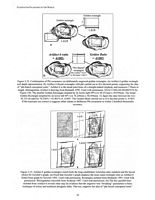 Artifact
6 golden rectangle and depth representation. (b) Artifact 6 fractal
rectangles with phi carried out to five decimal points, supporting the
idea of “phi-based conceptual units.” Artifact 6 is the
tarsal joint bone of a straight tusked elephant, and measures 170mm in
length. Bilzingsleben Artifact 6 drawing from Bednarik 1995. Used with
permission. EXACT MEASUREMENTS for Figure 12b: The smaller Golden
Rectangle (implied by its lower right 90� [angle sign]) is 48.351mm x
29.939mm. The larger Golden Rectangle (implied by its lower left
90� [angle sign]) is 78.236mm x 48.444mm. To figure the ratio between
the two: 48.351 divided by 78.236% = 61.801% or .61801. The Golden Mean
carried out to five decimal points is .61803. If the measures are
correct it suggests either innate or deliberate Phi awareness to within
2 hundred-thousandths accuracy.
Artifact
6 golden rectangle and depth representation. (b) Artifact 6 fractal
rectangles with phi carried out to five decimal points, supporting the
idea of “phi-based conceptual units.” Artifact 6 is the
tarsal joint bone of a straight tusked elephant, and measures 170mm in
length. Bilzingsleben Artifact 6 drawing from Bednarik 1995. Used with
permission. EXACT MEASUREMENTS for Figure 12b: The smaller Golden
Rectangle (implied by its lower right 90� [angle sign]) is 48.351mm x
29.939mm. The larger Golden Rectangle (implied by its lower left
90� [angle sign]) is 78.236mm x 48.444mm. To figure the ratio between
the two: 48.351 divided by 78.236% = 61.801% or .61801. The Golden Mean
carried out to five decimal points is .61803. If the measures are
correct it suggests either innate or deliberate Phi awareness to within
2 hundred-thousandths accuracy.
Figure 2.13. Artifact 6
golden rectangles match both the long-established Acheulian ratio
standard and the layout choice for Gowlett’s graph. (a) Proof
that Gowlett’s graph employs the exact same rectangle ratio as
Artifact 6. Detail from graph by Gowlett 1993. Used with permission.
Rectangles isolated from Bednarik 1995. Used with permission.
Bilzingsleben microlith from Svoboda 1987. Used with permission. (b)
The few parallel lines isolated from Artifact 6 reveals what may be
evidence that the engraver was “tweaking”
parameters–a basic technique of artists and technical designers
alike. This too, supports the idea of “phi-based conceptual
units.”
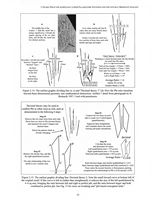 J. FELIKS: PHI IN THE ACHEULIAN: LOWER PALAEOLITHIC INTUITION AND THE NATURAL ORIGINS OF ANALOGY
J. FELIKS: PHI IN THE ACHEULIAN: LOWER PALAEOLITHIC INTUITION AND THE NATURAL ORIGINS OF ANALOGY
Page 23
Figure 2.14.
The earliest graphic dividing line (a–c) and “Decimal
theory 1” (d): How the Phi ratio translates beyond
three-dimensional geometry into mathematical abstraction. Artifact 1
detail from photograph by R. Bednarik 1997. Used with permission.
Figure 2.15.
The earliest graphic dividing line: Decimal theory 2. Note the small
inward curve at bottom left of the original motif. If this curve is
left in (rather than straightened), it reduces the size of the left
quadrilateral by 4–6 sq mm, bringing the ratio between left and
right to perfect phi, and the ratio between larger and both combined to
perfect phi. See Fig. 13 for more on tweaking and “phi-based
conceptual units.”
PLEISTOCENE PALAEOART OF THE WORLD
Page 24
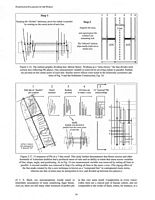 Figure 2.16.
The earliest graphic dividing line: Mirror theory. Working as a
“ratio mirror,” the line divides each section into
reflecting Phi planes. One measurement variable is removed by pivoting
radials to parallel. Radials are pivoted on the center point of each
line. Similar mirror effects were noted in the bilaterally-symmetric
phi lines of Fig. 9 and the Hofstetter Construction, Fig. 10.
Figure 2.16.
The earliest graphic dividing line: Mirror theory. Working as a
“ratio mirror,” the line divides each section into
reflecting Phi planes. One measurement variable is removed by pivoting
radials to parallel. Radials are pivoted on the center point of each
line. Similar mirror effects were noted in the bilaterally-symmetric
phi lines of Fig. 9 and the Hofstetter Construction, Fig. 10.
Figure 2.17. 14 instances of Phi in a 7-line motif. This study further demonstrates that Homo erectus
and other hominids of Acheulian tradition had a profound sense of ratio
and an ability to retain that sense across variables of line, shape,
angle, and positioning. As in Fig. 16 one measurement variable was
removed by setting all lines to parallel. A second variable was removed
in Step 4 by setting all lines to the same x axis. (The zigzag effect
of the line peaks created by the x-axis technique is known as a
“compound line” in contrapuntal music terms, wherein one
line of notes may be interpreted as two, and divided up between two
players.)
of J. S. Bach, our preconceptions would result in immediate assumption
of some underlying fugal theme. And yet, there are still many other
instances of perfect phi in this very same motif. Complexities in every
conceivable form are a natural part of human culture, and are
comparable to the works of Bach, where, for instance, in a
J. FELIKS: PHI IN THE ACHEULIAN: LOWER PALAEOLITHIC INTUITION AND THE NATURAL ORIGINS OF ANALOGY
Page 25
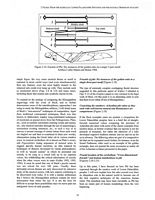 Figure 2.18. Fractals of Phi: Six instances of the golden ratio in a single 3-part motif. Artifact 2 after Mania and Mania 1988.
Figure 2.18. Fractals of Phi: Six instances of the golden ratio in a single 3-part motif. Artifact 2 after Mania and Mania 1988.
single fugue, the very same musical theme or motif is repeated in more varied ways (and even simultaneously) than any listener, even the most highly trained in the classical arts could ever keep up with. They include such as mentioned above (Figs. 2.8 & 2.9) and many more, including those that extend into symbolic fractal levels.
To expand on the analogy of comparing the Bilzingsleben engravings with the work of Bach, and to further demonstrate some of the interdisciplinary approaches I am using to study the Bilzingsleben artifacts, I will detail some of Bach’s “non-musical” techniques of composition. Apart from traditional contrapuntal techniques, Bach was also known to deliberately employ long-established techniques of mysticism as passed down from the Pythagoreans, Plato, etc., such as number symbolism (turning words and names, etc., into musical melodies through the use of numerology), acrostichon (writing sentences, etc., in such a way as to convey a second message if certain letters from each word are singled out and then re-combined to form new words), chiasmatism (using the Greek letter chi in various creative ways; in musical symbolism chi is known as Plato’s cross), and Figurenlehre (using sequences of musical notes to suggest specific human emotions, an idea inspired by techniques of rhetoric developed by Greek philosophers), as well as “puzzle canons” in which he presented one melody to be sung as a round with up to six separate voices, but withholding the critical information of exactly when the other voices were to enter (Feliks 1992, 1993, 1994). It must be noted that one of Bach’s puzzle canons was not solved for over 100 years. Usually, these intricately-woven themes are only discovered by intensive study of the musical scores, with new aspects continuing to be discovered even today. It is with a similar enthusiasm that I believe the Bilzingsleben artifacts contain far more information than meets the eye. It is not the least bit difficult to accept these possibilities once we move past our antiquated views of early peoples.
Fractals of phi: Six instances of the golden ratio in a
single three-part motif (Figure 2.18)
The type of extremely complex overlapping fractal structure suggested by this particular aspect of Artifact 2 (detailed in Figs. 2.9–2.12 of the Graphics paper) is very common in the fugal work of Bach. (At this point it is an interesting aside to note that Bach lived within 20 km of Bilzingsleben.)
Crunching the numbers: Acheulian phi ratios as they
rank with well-known natural and Renaissance art
comparisons (Figure 2.19)
If the Bach examples seem too esoteric a comparison for Lower Palaeolithic peoples, here is a brief list of straightforward numerical values comparing the precision of Acheulian phi ratios with some of the classic examples from modern times, as further evidence that our species is not the pinnacle of humanity, but rather the inheritors of a fully developed cognitive tradition entirely laid out and set up for us in advance. The following ratios are part of a comparative list that can be expanded much further; for instance, even the famed Parthenon, often used as an example of the golden rectangle, does not present the same accuracies as nearly all of the Acheulian evidence presented in this paper.
Fractal location of the cerebellum: “Cross-dimensional
fractals” and human indebtedness to phi
(Figures 2.20-2.21 & 2.22-2.23)
Up to this point, I have focused on how Phi has been expressed through the creative work of Lower Palaeolithic peoples. I will now explain how the ratio crossed over from its ubiquitous role in the natural world to become one of the first cognitive archetypes of the conscious human mind. This transition may have been inevitable, as Phi has been an innate part of human morphology from the very beginning.
PLEISTOCENE PALAEOART OF THE WORLD
Page 26
Figure 2.19. Acheulian Phi ratios as they rank with well-known natural and Renaissance art comparisons. (Note: The Gowlett averages provided are quick estimates by the author, and not by Gowlett.)
Many modern theorists agree that human self-awareness, for instance, came into being through the co-evolution of hand, eye, and brain (see Tallis 2003, Feliks 2006). 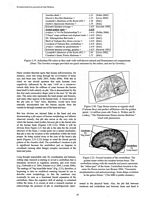 With this in mind, no one should question that early humans were cognitively influenced by the ratio 1.618 on a minute-to-minute daily basis for millions of years because the human hand itself is built entirely on phi. This is demonstrated by the fact that each consecutive finger joint to the next “is” the phi ratio. The same ratio represents the hand proper and forearm, and many other aspects of the human body. A visual sense of the phi ratio in “line” form, therefore, would have been naturally incorporated into the human psyche from the outside-in through constant use of the hand and arm.
With this in mind, no one should question that early humans were cognitively influenced by the ratio 1.618 on a minute-to-minute daily basis for millions of years because the human hand itself is built entirely on phi. This is demonstrated by the fact that each consecutive finger joint to the next “is” the phi ratio. The same ratio represents the hand proper and forearm, and many other aspects of the human body. A visual sense of the phi ratio in “line” form, therefore, would have been naturally incorporated into the human psyche from the outside-in through constant use of the hand and arm.
But less obvious are internal links to the hand and arm demonstrating a phi aspect of human morphology not hitherto observed, namely, that phi also serves as the very ratio in which the human mind resides, because phi is the fractal ratio of the human brain (Figures 2.20–2.23). While it will be obvious from Figure 2.21 that phi is the ratio for the overall structure of the brain, I would point out a deeper profundity, that phi is also the location of the cerebellum within the brain proper. Its being tucked away at the core of the brain’s phi spiral (Figures 2.21–2.22) brings to mind the fractal growth pattern of the Nautilus shell. The cerebellum’s location at phi is significant because the cerebellum just so happens to coordinate (among other things) complex movement of the hand and joints.
Long thought responsible only for coordination and balance, cutting edge research is starting to reveal a cerebellum that is intimately involved in cognition, emotion, and even music (e.g., Gottwald et al. 2004, Schutter et al. 2005, Levitin 2006). The analogy of “big brain/little brain” (Fig. 2.21), therefore, is beginning to take on multilevel meaning beyond its use to describe mere morphology, in that the cerebrum may eventually be seen as a functional fractal expansion of the cerebellum. Since the cognitive skill of analogy is contained within the brain, it is crucial at such a research juncture to acknowledge the presence of phi so unambiguously repre-
Figure 2.20. Type Homo erectus or ergaster skull (Turkana Boy) and perfect affiliation with the golden spiral. 1.6 million years old. From A. Walker and R. Leakey, “The Nariokotome Homo erectus Skeleton.” Used with permission.
Figure 2.21. Fractal location of the cerebellum: The golden mean within the modern human brain. The cerebellum (along with the medulla and pons) represents the “oldest part” of the brain. Cerebellum location is the same for Homo erectus (see Bruner 2004, “Geometric morphometrics and paleoneurology: brain shape evolution in the genus Homo.” (The MRI is public domain.)
sented in the physical brain. Also, the phi link between cerebrum and cerebellum and between brain and hand is
J. FELIKS: PHI IN THE ACHEULIAN: LOWER PALAEOLITHIC INTUITION AND THE NATURAL ORIGINS OF ANALOGY
Page 27
Figure 2.22. Fractal location of the cerebellum: The golden mean within the Homo erectus
skull and brain. The cerebellum is the part of the brain that
“understands” the positioning of the finger joints in
space. Every movement of the fingers, therefore, is an internal
confirmation of the phi ratio. The oldest part of the brain tucks away
in the whirls of a golden spiral. 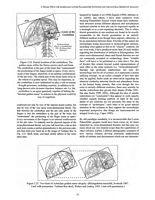 This may be important, as the
cerebellum is now understood to play a role in human thought processes,
including emotion, in addition to its long-known roles in motor
function, balance, etc. I.e. the cerebellum is an agent genuinely
capable of linking the “internal golden mean” to actions in
the physical world by way of cognition.
This may be important, as the
cerebellum is now understood to play a role in human thought processes,
including emotion, in addition to its long-known roles in motor
function, balance, etc. I.e. the cerebellum is an agent genuinely
capable of linking the “internal golden mean” to actions in
the physical world by way of cognition.
confirmed not only by way of the internal neural system, but also by
way of the very same cross-dimensional fractal. The link between the
cerebellum and the phi ratio joints of the fingers is that the
cerebellum is the part of the brain that “understands” the
positioning of the finger joints in space. Every movement of the
fingers is an internal confirmation of the phi ratio. To instantly test
the physical aspects of the cross-dimensional fractal, curl your left
hand into a fist so that each joint creates a perfect perpendicular to
the previous joint, and then hold your hand up to the image of Turkana
Boy in Fig. 2.22. Skull, brain, and hand clearly adhere to the exact
same ratio.
Inspired by Eglash et al (1998) Eglash (1999), Mikiten et. al.
(2000), and others, I have done extensive work studying Palaeolithic
fractals which retain their mathematical structure across different
physical and non-physical mediums (similar to how phi can be expressed
equally as a rectangle or as a non-repeating decimal). This is where
fractal geometries in one medium are found to be exactly comparable to
the fractal geometries in an entirely different medium even though
there appears, otherwise, to be no association between them. Fractals
of this nature are increasingly being discovered in archaeological
contexts, including what appear at first to be “chaotic”
contexts. (In my own work, I have produced more than 20 such
studies regarding the distribution of artifacts at Bilzingsleben. But
since cross-dimensional chaos and fractal theories are not yet commonly
accepted in archaeology these “testable facts” will have to
be published at a later date.) The idea of fractals that extend beyond
scaled representations of each other in the same medium (i.e.
“cross-dimensional” fractals) has profound implications not
only for archaeology but for all of science, as it represents a potent
unifying concept. As an earlier example of how this idea may be
applied, Sacks made an observation regarding the identical similarity
between fossils and phosphene forms in the human brain, namely, that
even though the two exist in entirely different mediums, there may
actually be similar restrictions that govern their shapes (Feliks 2003.
See also Sacks 1999, 2002). Although the idea of similar restrictions
(or “constraints”) that appear to work equally whether
regards fleeting patterns of light or the hard shells of sea creatures
are not precisely the same as the concept of “archetypes,”
each need to be given special attention in the sciences as they support
the increasingly important perspective that things are interconnected
on integral levels (e.g., Capra 1982).
By old paradigm standards, it is inconceivable that Lower Palaeolithic
peoples could have been aware of, let alone interested in,
cross-dimensional fractals; but this may say more about our own limited
scope than the capabilities of other cultures. Earlier, I offered
ethnographic examples of how various cultures develop extremely
sophisticated skills of subtlety and discernment which are not
character-
Figure 2.23. Two facts of Acheulian golden mean ubiquity. (Bilzingsleben microlith, Svoboda 1987.
Used with permission. Turkana Boy skull, Walker and Leakey 1993. Used with permission.)
PLEISTOCENE PALAEOART OF THE WORLD
Page 28
ristics of what we typically regard as “Western” culture.
It should not be at all surprising, therefore, to find that people of other cultures are (or were) “better than us” at
all kinds of different things, or who have “beat us” to skills or ideas we would like to take credit for ourselves.
Eglash’s recent discovery of fractal layouts in traditional
African villages which have always been before our Western eyes proves
this point. Again, just as our above-mentioned difficulties in seeing
refinement as opposed to crudeness, our inability until recently to
even see fractal layouts is due in part to our long preoccupation with
the Cartesian grid system. This view of reality, predominant in Western
science, attempts to organize everything according to
arbitrarily-imposed equal increments, often reducing everything to
“on-off” mechanics or “bits-and-pieces” rather
than seeing everything as “interconnections” (perspective
as per Capra [1982], Bohm and Peat [1987] etc.). Fractal values depend
entirely upon interconnections. Fractal measurements can even reveal
strong relationships between seemingly unrelated aspects of reality,
effectively offering a science which is not incompatible with meaning.
When Eglash first discovered fractals in African village layouts his
initial scientific inclination was to see them as the result of
unconscious organization; but his perspective changed after fieldwork,
and he began to see intentional fractals as aspects of a knowledge
system. Remarkably, the fractals were cross-dimensional; not only were
they present in village layouts but also as miniature scale models of
the villages within the village houses–components of religious
altars–thus showing a direct fractal link between physical and
spiritual worlds. 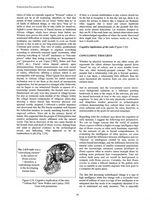 Inspired, I followed a similar sequence and
discovered that the Phi fractal extended well beyond the Acheulian
handaxe to exactly matching fractals in the engraved artifacts. Since
phi is the primary fractal of nature, this suggested that the people of
Bilzingsleben had creative inclinations closely affiliated with the
natural world. This led to discovery of the very same fractals in the
human brain and skull of Homo erectus,
linking brain and mind to physical evidence in the archaeological
record, and indicating, what appeared to be an indebtedness to phi
(Fig. 2.24).
Inspired, I followed a similar sequence and
discovered that the Phi fractal extended well beyond the Acheulian
handaxe to exactly matching fractals in the engraved artifacts. Since
phi is the primary fractal of nature, this suggested that the people of
Bilzingsleben had creative inclinations closely affiliated with the
natural world. This led to discovery of the very same fractals in the
human brain and skull of Homo erectus,
linking brain and mind to physical evidence in the archaeological
record, and indicating, what appeared to be an indebtedness to phi
(Fig. 2.24).
Figure 2.24. Cognitive implication of the ratio. “Turkana Boy” from Walker and Leakey 1993. Used with permission.
If there is a human indebtedness to phi, science should not be the last
to recognize it. In this day and age, there is no reason for science to
behave like a religion (as Bednarik often suggests that it does) and
censor legitimate observations and measurements on the grounds that
they may invite absurd deductions. Let scientists interpret as they see
fit. If the math bears out, factual observations must be acknowledged
regardless of where the newly discovered facts might lead. This is how
science works–or, at least, how it should work.
Cognitive implication of the ratio (Figure 2.24)
CONCLUDING THOUGHTS
Whether by physical innateness or any other cause, phi represents the
oldest abstract knowledge passed down “intact” by way of culture, and
in more testable forms than
any other humanly-grasped concept. That early peoples had a
relationship with phi is beyond question, and it was likely a
relationship little different than the same fascination phi receives
from our own species in modern times.
Just as astronomy uses the ever-present cosmic microwave background
radiation as a reference pointing backwards in time to the origin of
the universe, phi may be traced backwards in time to the very origin of
human cognition. To date, phi is the only physically confirmable and
ubiquitous number preserved as archaeological evidence demonstrating
how cultural ideas were able to cross millennia and even species. Its
value, therefore, is immeasurable in the quest for universal meanings.
Regarding what the evidence says about the cognition of early humans, I
suggest the following new perspective. We can no longer assume that the
world of modern Homo sapiens reflects a higher average intelligence than that of Homo erectus
or other early hominins, especially by the measure of phi or fractal
comprehension. In evaluating the intelligence of other species, we must
keep in mind the difference between intelligence and our
“illusion” of intelligence created by easy access to
culture-based knowledge, and the difference between the natural value
systems of smaller communal populations and the increasingly unnatural
systems developed by Homo
sapiens often to resolve issues brought about by nothing more profound
than overpopulation. Take our culture bank away and we would be
hard-pressed to compete with Homo erectus. Certainly, the first Homo erectus
to create a bifacial handaxe in the golden ratio was as capable as any
modern engineer who now goes to a computer for quick specs.
The idea that increasing technological change is a sign of high
intelligence while less change with a successful track record of
millions of years is a sign of low intelligence is an antiquated idea
that needs to be completely discarded if we are to understand our early
ancestors. This is especially
J. FELIKS: PHI IN THE ACHEULIAN: LOWER PALAEOLITHIC INTUITION AND THE NATURAL ORIGINS OF ANALOGY
Page 29
important when we study a period in which phi was so prevalent. The ancient Greeks themselves regarded phi in high esteem, perhaps best summed up by Plato’s famous accolade in which he refers to the golden section as nothing less than the “key to the physics of the cosmos” (Timaeus). If we discover the use of phi, therefore, to have been common during Lower Palaeolithic times, we, as scientists, need to look at the implications very closely. Our own preoccupations with technology aside, in all likelihood Homo erectus/ergaster, Neanderthals, and heidelbergensis were the species that invented virtually everything that cognitively defines humanity.
Once the fractal human mind was switched on perhaps two million years ago, the whole range of emotions, language, and philosophy were instantly available. Clearly, there is a much longer history opening up, indicating that the cognitive richness of early peoples is not at all accurately reflected in our past interpretations of their stone tool technologies. I have provided openly testable archaeological evidence that the earliest cognitive abilities appear directly related to ratio and analogy, each of which are accessible through the phi fractal. In fact, it may well be that all human morphology and cognition is based on fractals and the phi fractal in particular. It seems that by looking anew at phi we will begin to understand an essential and fundamental aspect of human nature.
Acknowledgments
I would like to thank the following scholars for encouragement and/or contributions to my work during the past few years. In alphabetical order: Robert Bednarik, David Brill, Noam Chomsky, Ekkehart Malotki, Ellen Dissanayake, Adrienne Mayor, Steven Pinker, Oliver Sacks, and Raymond Tallis. In addition, I wish to thank my family and friends, and others who have offered support and inspiration; but I wish especially to thank the eleven sponsors who made my presentations in Lisbon possible.
Publication note
Phi in the Acheulian was presented in Lisbon instead of the program, Legends of the Sea. However, it was not listed in the UISPP Book of Abstracts. Ironically, the “Legends of the Sea” abstract was only a rough draft not intended for publication. Since the abstract was published, it is important to the author that one critical fact be clarified; Legends of the Sea is an opera inspired by the bamboo raft archaeology of Robert Bednarik replete with all manner of human relationships, aspirations, tragedies, and achievements. Since none of this explanatory information was included, readers had no idea as to why the abstract referred so much to emotional content, and thus misunderstood the author’s intentions.
References
BEDNARIK, R.G. 1995. Concept-mediated marking in the Lower Palaeolithic. Current Anthropology 36: 605–34.
BEDNARIK, R.G. 1997. The origins of navigation and language. The Artefact 20:16–56.
BEDNARIK, R.G. 2003. The earliest evidence of palaeoart. Rock Art Research 20: 89–135.
BOHM, D. and F. PEAT. 1987. Science, order, and creativity: A dramatic look at the roots of science and life. Bantam Books, New York.
BRUNER, E. 2004. Geometric morphometrics and paleoneurology: brain shape evolution in the genus Homo. Journal of Human Evolution 47: 279–303.
CAPRA, F. 1982. The turning point: Science, society, and the rising culture. Simon and Schuster, New York.
CHOMSKY, N. 1972. Language and mind. Enlarged Edition. Harcourt Brace Jovanovich, Inc. New York.
CORMAC, E.M. and M.I. STAMENOV (Eds.). 1996. Fractals of brain, fractals of mind: In search of a symmetry bond. Amsterdam, Philadelphia, John Benjamins Publishing Co.
DISSANAYAKE, E. 1989. What is Art For? Seattle and London: University of Washington Press.
DONALD, M. 1991. Origins of the modern mind: three stages in the evolution of culture and cognition. Cambridge: Harvard University Press.
EGLASH, R., C. S. DIATTA and N. BADIANE 1998. Fractal structure in Jola material culture. Paper presented at the Congr�s “D�veloppement insulaire durable et r�les de la recherche et de la formation.” Rhodes, Greece. 277–83.
EGLASH, R. 1999. African fractals: Modern computing and indigenous design. Rutgers University Press, New Jersey.
FALBO, C. 2005. The golden ratio – a contrary viewpoint. The College Mathematics Journal, 36(2): 123–134
FELIKS, J. 1992, 1993, 1994. The Tao of Bach: J.S. Bach, mysticism, and ancient Chinese philosophy. Pp. 1–53. Widely circulated unpublished thesis.
FELIKS, J. 1997a, 1997b. The impact of fossils. Preliminary drafts submitted for publication and widely circulated. [1995 version, while not specifically cited here, was also submitted for publication in the field, and widely circulated.]
FELIKS, J. 1998a. The impact of fossils on the development of visual representation. Rock Art Research 15: 109–34. (1995–97 versions submitted for publication and widely circulated).
FELIKS, J. 1998b. The value of interpretive approaches in archaeology. Rock Art Research 15: 128–29.
FELIKS, J. 2000. Iconic interface between the worlds. Comment on D. Hodgson, “Art, perception, and
PLEISTOCENE PALAEOART OF THE WORLD
Page 30
information processing: an evolutionary perspective.” Rock Art Research 17: 23–25.
FELIKS, J. 2003. Toward a comprehensive paradigm. Comment on Robert G.
Bednarik, “The earliest evidence of palaeoart.” Rock Art Research 20: 111–14.
FELIKS, J. 2006a (submitted and circulated 2004–5). Musings on the Palaeolithic fan motif. In P. Chenna Reddy (ed.), Exploring the mind of ancient man: Festschrift to Robert G. Bednarik, 249–66. Research India Press, New Delhi.
FELIKS, J. 2006b. The Graphics of Bilzingsleben: Sophistication and subtlety in the mind of Homo erectus. Visual thesis presented in The Pleistocene palaeoart of the world session, Chaired by Robert Bednarik and Derek Hodgson. XVth UISPP Congress, Lisbon, September 7, 2006.
GOTTWALD, B., B WILDE, Z MIHAJLOVIC and H.M. MEHDORN. 2004. Evidence
for distinct cognitive deficits after focal cerebellar lesions. Journal of Neurology, Neurosurgery and Psychiatry 75:1524-31.
GOWLETT, J.A.J. 1984 Mental Abilities of Early Man: A Look at Some Hard Evidence, in Hominid Evolution and Community Ecology: prehistoric human adaptation in biological perspective. Edited by Robert Foley. London: Academic Press.
GOWLETT, J.A.J. 1993. Ascent to civilization: The archaeology of early humans. 2nd Edition. The McGraw-Hill companies.
GREENE, B. 1999. The elegant universe: superstrings, hidden dimensions, and the quest for the ultimate theory. First Vintage Books Edition, New York.
HARROD, J.B. 2003. Lower Palaeolithic palaeoart, religion and
protolanguage. Comment on “The earliest evidence of
palaeoart” by Robert G. Bednarik. Rock Art Research 20:115–16.
HOFSTETTER, K. 2002. A simple construction of the golden section. Forum Geometricorum (2): 65–6.
HREB�CEK, L. 1994. Fractals in language. Journal of Quantitative Linguistics 1(1): 82–6.
K�HLER, R. 1997. Are there fractal structures in language? Units of measurement and dimension in linguistics. Journal of Quantitative Linguistics 4(1-3): 122–125.
LEOPOLD, E. 2001. Fractal structures in language: The question of the
imbedding space. In L. Uhlirova, G. Gejza, G. Altmann, R. K�hler
(eds.), Text as a linguistic paradigm: Level, constituents, constructs. Festschrift in honour of Ludek Hreb�cek. pp. 163-76. Wissenschaftlicher Berlag Trier.
LEROI-GOURHAN, A. 1961. Les Fouilles d’Arcy-Sur- Cure (Yonne). Gallia Prehistoire 4:3–16.
LEROI-GOURHAN, A. 1964. Les Religions de la Pr�histoire (Pal�olithique). Paris: Presses Universitaires de France.
LEVITIN, D. 2006. This is your brain on music: The science of a human obsession. Dutton, New York.
LIVIO, M. 2002. The golden ratio: The story of phi, the world’s most astonishing number. Random House, New York.
MANDELBROT, B. 1982. The Fractal Geometry of Nature. W. H. Freeman & Co.
MAYOR, A. 2005. Fossil Legends of the First Americans. Princeton University Press, Princeton.
MANIA, D. and U. MANIA 1988. Deliberate engravings on bone artefacts of Homo erectus. Rock Art Research 5: 91–107.
MANIA, D. and U. MANIA 2003. Bilzingsleben - Homo erectus, his culture
and his environment. The most important results of research. In J. M.
Burdukiewicz and A. Ronen (eds.), Lower Palaeolithic small tools in Europe and The Levant. BAR S1115, pp. 29–48.
MANIA, D. and U. MANIA 2005. The natural and sociocultural environment
of Homo erectus at Bilzingsleben, Germany. In C. Gamble and M. Porr
(eds.), The Hominid Individual in
Context: Archaeological investigations of Lower and Middle Palaeolithic
landscapes, locales and artifacts, 98–114. Routledge, New York.
MARSHACK, A. 1977. The meander as a system: the analysis and
recognition of iconographic units in Upper Paleolithic compositions. In
Form in Indigenous Art, Prehistory and Material Culture Series, No. 13, ed. P. J. Ucko (Canberra: Australian Institute of Aboriginal Studies), pp. 286–317.
MARSHACK, A. 1990. Early hominid symbol and evolution of the human capacity. In P. Mellars (ed.), The emergence of modern humans: an archaeological perspective, pp. 457–98. Cornell University Press, Ithaca, N.Y.
MAYOR, A. 2005. Fossil Legends of the First Americans. Princeton University Press, Princeton.
MIKITEN, T.M., N.A. SALINGAROS, and H-S YU. 2000. Pavements as embodiments of meaning for a fractal mind. Nexus Network Journal 2: 63–74. http://www.nexusjournal.com/Miki-Sali-Yu.html. (To appear in A Theory of Architecture by Nikos A. Salingaros. Umbau-Verlag, Solingen).
MITHEN, S. 2003. Handaxes: the first aesthetic artefacts. In V. Eckhart and K. Grammer (eds.), Evolutionary Aesthetics, pp. 261–275. Springer Berlin, New York.
OAKLEY, K.P. 1973. Fossil shell observed by Acheulian man. Antiquity 47: 59–60.
OAKLEY, K.P. 1981. Emergence of higher thought, 3.0– 0.2 Ma B.P. Philolosophical Transactions of the Royal Society of London B 292: 205–11.
PEAT, F.D. 1990. Mathematics and the language of nature. In R. E. Mickens ed.), Mathematics and sciences. Word Scientific. http://www.fdavidpeet.com/bibliography /essays/text/maths.
J. FELIKS: PHI IN THE ACHEULIAN: LOWER PALAEOLITHIC INTUITION AND THE NATURAL ORIGINS OF ANALOGY
Page 31
PINKER, S. 1994. The language instinct: How the mind creates language. William Morrow and Company, Inc., New York.
SACKS, O. 1999. Migraine. Revised and expanded edition. First Vintage Books Edition, Random House, New York.
SACKS, O. 2002. Oaxaca journal. National Geographic Society, New York.
SCHUTTER, DENNIS J.L.G. and JACK VAN HONK. 2005. The cerebellum on the rise in human emotion. The Cerebellum 4: 190–94.
SVOBODA, J. 1987. Lithic industries of the Arago, V�rtessz�ll�s, and Bilzingsleben hominids: Comparison and evolutionary interpretation. Current Anthropology 28(2): 219–27.
TALLIS, R. 2003. The hand: a philosophical inquiry into human being. Edinburgh University Press, Edinburgh.
WALKER. A. and R. LEAKEY. 1993. The Nariokotome Homo erectus skeleton. Harvard University Press, Cambridge.
WHITE, R. 1989a “Toward a Conceptual Understanding of the Earliest Body Ornaments,” in The Emergence of Modern Humans: Biocultural adaptations in the later Peistocene. Edited by Erik Trinkaus, pp. 211–31. Cambridge University Press.
WHITE, R. 1993 The Dawn of Adornment. Natural History 102:60–7.
WYNN, T. 2002. Archaeology and cognitive evolution. Behavioral and Brain Sciences 25: 389–438.
WYNN, T. 2003. The constraint of minimum necessary competence. Comment on Robert G. Bednarik, “The earliest evidence of palaeoart.” Rock Art Research 20: 120–21.
 (Graphic by John Gowlett 1993. Ascent to Civilization: The Archaeology of Early Humans.
Used with permission of The McGraw-Hill Companies. Ratio numbers were
added for clarity.) While not identified as the “golden
ratio,” it is now known as the general ratio of choice for
handaxes during the Acheulian. (b) Gowlett’s homage to the ratio
in his graphic layout choices, representing the most efficient example
of Phi’s ubiquitous role in human creativity.
(Graphic by John Gowlett 1993. Ascent to Civilization: The Archaeology of Early Humans.
Used with permission of The McGraw-Hill Companies. Ratio numbers were
added for clarity.) While not identified as the “golden
ratio,” it is now known as the general ratio of choice for
handaxes during the Acheulian. (b) Gowlett’s homage to the ratio
in his graphic layout choices, representing the most efficient example
of Phi’s ubiquitous role in human creativity. 
 Page 15
Page 15


 Page 20
Page 20




 With this in
With this in
 Inspired, I followed a similar sequence and
discovered that the Phi fractal extended well beyond the Acheulian
handaxe to exactly matching fractals in the engraved artifacts. Since
phi is the primary fractal of nature, this suggested that the people of
Bilzingsleben had creative inclinations closely affiliated with the
natural world. This led to discovery of the very same fractals in the
human brain and skull of
Inspired, I followed a similar sequence and
discovered that the Phi fractal extended well beyond the Acheulian
handaxe to exactly matching fractals in the engraved artifacts. Since
phi is the primary fractal of nature, this suggested that the people of
Bilzingsleben had creative inclinations closely affiliated with the
natural world. This led to discovery of the very same fractals in the
human brain and skull of